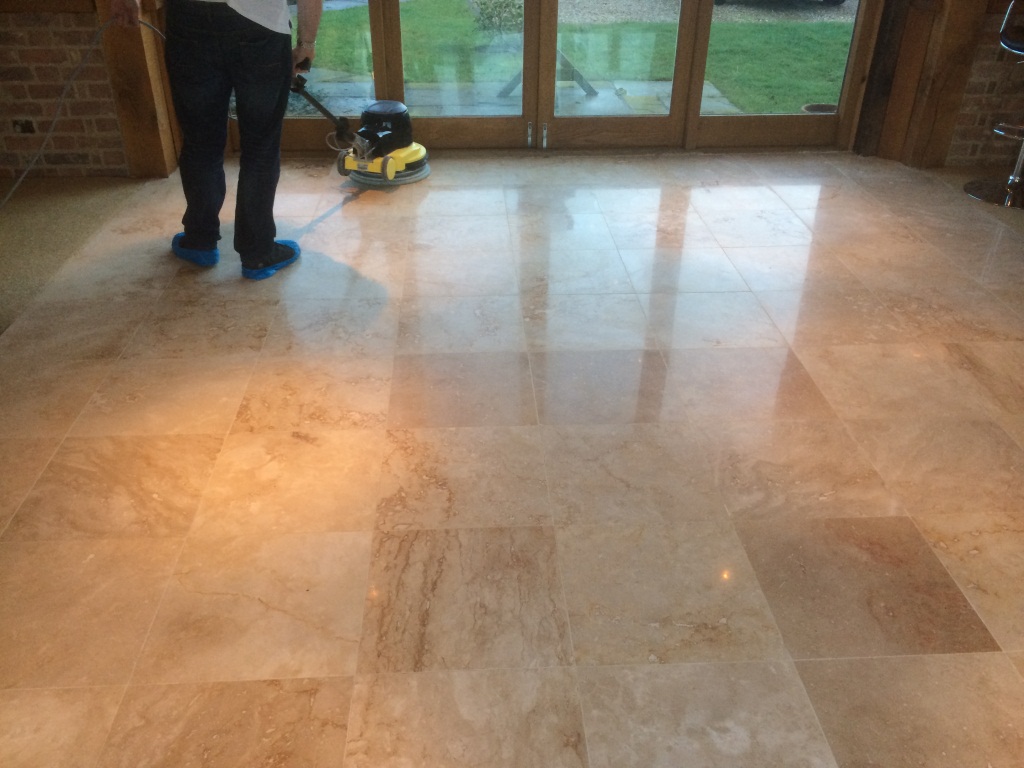Travertine, which forms from limestone under immense pressure, creates astonishingly beautiful and functional decorative applications for backsplashes, showers, floors and countertops. However, cleaning and maintaining the porous stone produce challenges because travertine etches, stains, cracks, pits and suffers damage from extreme heat and cold. Regular cleaning, sealing and polishing are essential to protect the stone from chipping, etching and cracking and keeping the patterns warm and beautiful with the unique color characteristics that enhance almost any decorating scheme. Special nonacidic cleaners, sealers and polishes are needed — along with special cleaning techniques — to keep travertine looking its best and lasting for the longest possible time.
Travertine is formed when the minerals in groundwater form limestone, which turns into travertine when placed under intense pressure. When travertine is placed under pressure, it eventually turns to marble. Therefore, limestone, travertine and marble share many characteristics, such as porous surfaces and sensitivity to acidic substances like juices, wine and certain harsh chemicals. Cleaning, sealing and polishing any of these natural stones are more challenging than maintaining other types of decorative stone.
Travertine etches, cracks and chips easily if not cleaned and maintained properly, but taking a little care with travertine surfaces produces gorgeous surfaces for floors, showers, countertops and backsplashes. The color characteristics range from light ivory to vibrant scarlet, and walnut, gold and silver colors with intricate patterns predominate and complement almost any decorating style. However, knowing how to care for travertine is important before deciding to use the stone in your home.
Types of Travertine Finishes
Cleaning, sealing and polishing travertine depend on the finish and whether the stone is filled or unfilled. The types of travertine finishes include:
- Tumbled
This finish is the most natural and features lots of texture. The texture is difficult to clean and needs frequent dusting or vacuuming to prevent dirt particles from damaging the stone. Tumbled floors can be damaged by heavy vacuum cleaners when the wheels grind dirt into the surface.
- Honed
Honed travertine is the most popular finish for home decorating. The finish is flat, smooth and shiny, and it keeps its low-shine matte finish better if treated with a pH balanced sealer.
- Polished
Polished travertine is polished to a high gloss and most closely resembles marble. Keeping the shine requires regular cleaning, stripping and polishing with neutral pH maintenance products.
- Brushed
This finish has a matte appearance and rougher texture than honed or polished travertine.
- Unfilled
Unfilled travertine is the stone in its natural porous state with holes, depressions and textured pitting.
- Filled
Filled finishes utilize dust byproducts from the cutting and shaping processes to fill in the holes by adding a cement hardener. The dust matches the natural colors of the stone.
Step-by-Step Travertine Cleaning Instructions
Travertine, regardless of finish, needs regular cleaning and protection against spills and excessively hot or cold foods. That’s why you should always use coasters and placemats to protect travertine countertops. Clean spills quickly by blotting them up and cleaning with disinfecting wipes that use a pH neutral cleaner. Dusting and vacuuming regularly are important to prevent dirt from accumulating and scratching or etching the stone’s surface.
Always blot liquid spills instead of rubbing to prevent pushing the liquid further into the pores. The safest cleaners for travertine are nontoxic, nonacidic, pH neutral and contain no phosphates or ammonia. If using cleaners on countertops, make sure the cleaners are safe for use on food-preparation surfaces. Best practices for cleaning travertine surfaces include:
- Blot spills immediately.
- Dust often, but vacuuming is better for getting the dirt particles that settle in the pores. However, you might need a portable vacuum or wand attachment to prevent the vacuum’s wheels from grinding dirt into floor surfaces.
- Use pH neutral wipes, sponges, soft cloths and pH neutral cleaners to clean travertine surfaces.
- Neutral pH is represented by the pH number 7. Your cleaners, sealers and polishes should always be phosphate-free, mildly abrasive and preferably biodegradable.
- Rinse surfaces after cleaning with warm water to remove residue.
- In travertine showers, store toiletries in decorative trays to prevent spills and damage from the chemicals in beauty products.
- Honed travertine surfaces need sealing to protect them from stains and etching.
- Dusting travertine floors is best done with an untreated dust mop.
- Protect high-traffic areas of travertine floors with door mats or carpet runners.
- You can treat stubborn stains with poultices made from acetone mixed with baking soda to the consistency of pancake batter. Apply the poultice, let it work overnight and then remove. The stain should be less visible, but it might take several treatments. Stubborn stains might require hiring a restoration specialist. After any treatment, reseal the stone and polish the area 24 hours later.
Sealing and Polishing Travertine
Protective sealing is critical for protecting natural stone because the seal prevents juice, wine or coffee from staining or etching the surface. which could lead to a costly repair or replacement. You can test the seal by pouring water on the travertine’s surface to cover about 3 inches of the surface. Let the water sit for 30 minutes. Check several areas because travertine can wear unevenly in different places. If the water beads, the seal is still good. If the seal is weak, a dark ring will appear where the water penetrated the stone. You will need to seal again, but check for etching and staining, and repair any damages first. After sealing, wait 24 hours before polishing the stone.
Your travertine surfaces will look incredible and last longer if you clean and protect them properly. Protect your surfaces from hot and cold items, wipe up spills quickly, clean with pH neutral cleansers and seal and polish as needed.
For more information visit: Granitegold.com.

